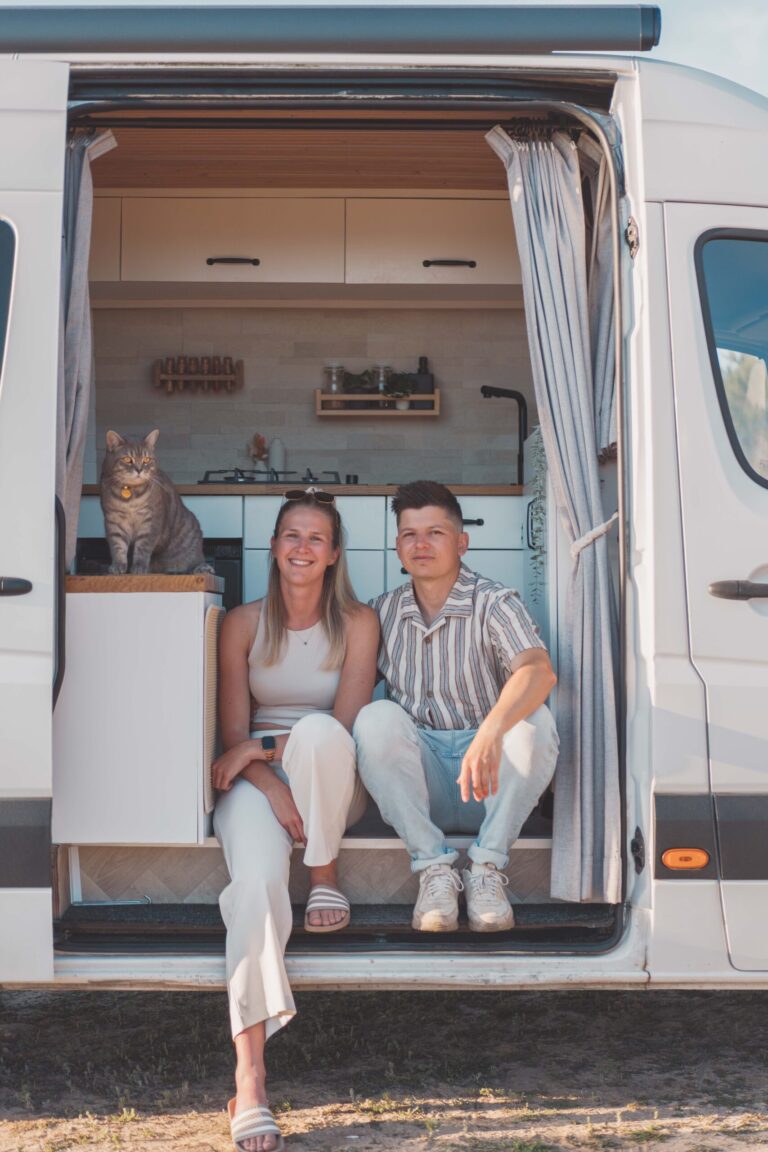Overview
Note
Installing electricity is not without risk. We are not responsible for your electrical installation. Always have your electrical diagram and electrical installation checked by a professional or outsource it entirely.
Calculate your consumers
So where to start to provide yourself with electricity? First you’ll have to determine where you want to lay your electrical wires. Depending on the bodywork of your van, you can either let them run through the bodywork behind the insulation or you can choose to lay everything after you’ve finished insulating. In this way it’s easier to reach it again afterwards.
We decided to run our electrical wiring behind our furniture, but in front of our walls to make it more accessible. The wires for our lighting we placed on top of the ceiling panels while we were placing them. So, the wires for our roof hatch and from the light switch to the lights in the ceiling are the only ones running behind our wall.
To provide yourself with electricity, you can choose to only use your car battery, although this is really inadvisable as you don’t want this battery to run out. We highly recommend you buying a camper battery. You can recharge it in different ways such as shore power with a battery charger, solar panels or a dynamo.
The capacity of your battery depends on your power consumption. But there are many other things to consider when choosing a battery and inverters. Try to calculate how much you’ll need and keep in mind that these kind of batteries should never be fully discharged.
To calculate Ampere-hours (Ah), you’ll need to know the power consumption in Watts (W) and the operating time in hours (h). The formula for calculating Ah is as follows:
Ah = (Watt-hours (Wh)) / Voltage (V)
To calculate Watt-hours (Wh), multiply the power consumption in Watts (W) by the operating time in hours (h). Once you have the Watt-hours, divide it by the voltage (V) of your camper’s electrical system to obtain the Ah.
For example, let’s say your camper appliances consume a total of 200 Watts and you plan to use them for 4 hours:
Watt-hours (Wh) = 200 Watts x 4 hours = 800 Watt-hours (Wh)
If your camper’s electrical system operates at 12 Volts:
Ah = 800 Watt-hours (Wh) / 12 Volts = 66.67 Ah
So, in this example, you would need a battery with a capacity of approximately 66.67 Ah to power your camper appliances for 4 hours.
It’s important to note that this calculation provides an estimate based on ideal conditions and doesn’t account for factors such as battery efficiency, losses in conversion, or variations in power consumption. It’s always a good idea to add a buffer and choose a battery with slightly higher capacity than the calculated value to ensure sufficient power supply.
Below you can find an example of how we made our calculation.
So we have a maximum total consumption per day of 152 Ah. To be on the safe side, add another 10% here so that you will certainly have enough capacity. In our case, this means that we need a battery capacity of at least 167 Ah.
These figures are calculated on the maximum consumption, so a refrigerator and fan on the highest setting, inverter on full load, … . in reality, the fan is mostly at the lowest setting and the refrigerator at 50-60% of its capacity (depending on the outside temperature).
From now on you can start looking at which batteries, solar panels and fuses you need.
Choose your battery
Now that you know how much consumption you have per day, you can choose the suitable battery. There are many different types of batteries, but AGM or LiFePo4 are usually chosen here. We briefly explain some differences here.
Chemistry
LiFePO4 batteries, as the name suggests, use lithium iron phosphate as the cathode material. AGM batteries, on the other hand, are a type of lead-acid battery that uses an absorbed glass mat separator and sulfuric acid electrolyte.
D.O.D. (Depth Of Discharge)
LiFePO4 batteries have a higher usable capacity and can be safely discharged to a greater extent (often around 80% or more of their capacity) without causing significant damage or shortening their lifespan. AGM batteries, on the other hand, have a lower depth of discharge (around 50% to 60%) to maintain optimal performance and longevity.
Weight and size
LiFePO4 batteries are generally lighter and more compact than AGM batteries with the same capacity. This weight advantage can be significant for applications where weight reduction is a priority, such as in mobile or off-grid setups.
Cost
LiFePO4 batteries are typically more expensive upfront compared to AGM batteries. However, when considering the longer lifespan, higher usable capacity, and improved performance, they often provide better long-term value.
Conclusion: a LiFePo4 battery is the best option. However, we have chosen the AGM batteries for budget reasons and as long as they work properly, we will keep them. After this we will definitely switch to the LiFePo4 batteries.
We have connected 3x an AGM battery of 12v – 140Ah in parallel, giving us a total capacity of 420Ah at 12V.
So because we have AGM batteries, we have a discharge rate of 50%. Which means that we can effectively use ‘only’ 210Ah of our 420Ah to give our batteries a longer lifespan.
There is also a difference how you connect the batteries, you can connect them in series or parallel. With a parallel circuit (picture below) you connect the positive sides together and you increase the capacity (Ah) but stay at the same voltage (V).
In a series connection you connect the positive side to the negative side of the other battery and you increase the voltage (V) but the capacity (Ah) remains the same.
A parallel setup looks like this:
A series setup looks like this:
Charge your batteries
We can charge our batteries in 3 ways, via solar panels, shore power and the alternator.
In 99% of cases, the solar panels are actually enough for us. We live 24/7 in our van and because we have taken enough margin on our batteries / consumption, we can live perfectly full time off grid. Below we go a little deeper into our setup of the charging part.
Solar Panels
To charge via solar panels you also need an MPPT (Maximum Power Point Tracking). This MPPT is a regulator that will ensure that the power generated by the solar panels is optimally transferred to the batteries at the correct voltage.
We have provided 2 solar panels with 155W each, in this case they are connected in series. Our solar panels can generate a maximum of 310W per hour in optimal conditions. In real circumstances we are between 200W and 250W on a sunny day. So if you make the calculation from above that we have a maximum consumption of approximately 1800W on 1 day, then we need 7-8 hours of sunshine per day to make up for this.
Those figures are calculated on the maximums, we do not charge our laptop every day, the refrigerator is not always on the maximum setting or the fan is certainly not always at full power for 12 hours in a row. In reality we consume 400 to 500W per day. Which means that the solar panels need a minimum of 3 hours of good sunlight to keep our batteries in full condition.
We will of course set the fan to a higher setting at warm temperatures, just like the refrigerator. But warm temperatures also often bring sunny days, so this is not a problem. You also spend more time outside the camper, so you have to use the lighting less.
Shore power
In another blog post we explained how we made a hole in the side of our motorhome to plug in an electrical outlet. We have connected this to a Blue Smart Charger from Victron. You can also easily read this via Bluetooth via your phone. However, we only use it in emergencies when we run into battery capacity problems.
How to install a shore plug
DC-DC Charger (Via alternator)
We have chosen a DC/DC charger here, the BuckBoost TS800C/50 because it works on vibrations. So as soon as the engine starts and the device measures vibrations, it switches on and sends the current to the battery. There is a switch in between to turn it off because we only use it in emergencies when we almost run out of battery. When using, you also have to take into account a higher consumption of your petrol.
The TS 800C/50 has a maximum output current of 50A, which we have limited to 25A because we also monitor this through our Simarine system, which has a maximum throughput of 30A per channel. But we will explain this at a later stage.
Now that we have chosen our batteries and how we are going to charge them, we can move on to what else we need for our electrical installation.
Inverter
You also need power to charge, for example, your laptop. You can (usually) not do this with the 12v that your battery supplies. For this we will need an inverter that converts the power from 12v DC (Direct Current) to 230v AC (Alternating Current), in this section we explain which one we chose and why.
Inverter types
There are two important differences with inverters. You have inverters with pure and modified sine waves.
- A pure sine wave is a smooth and continuous waveform that resembles a curve. It follows the mathematical function of a sine wave, where the voltage or current smoothly transitions from positive to negative values and back again. It has a consistent amplitude, frequency, and phase. Pure sine waves are considered ideal and have low harmonic distortion. They are similar to the waveforms found in nature and provide a clean and stable power source.
- A modified sine wave, also known as a modified square wave, is a waveform that approximates a sine wave but has a more blocky or stair-step-like shape. Instead of smoothly transitioning between positive and negative values, it consists of straight lines with abrupt changes. Modified sine waves are created by modifying a square wave, typically by shaping its edges. The resulting waveform contains multiple harmonic components in addition to the fundamental frequency. The amplitude, frequency, and shape of the modified sine wave can vary depending on the specific design.
Modified sine waves are commonly used in power inverters and electronic devices that need to convert DC power to AC power. They are less expensive to generate compared to pure sine waves and can power most basic electronics and appliances. However, certain devices that rely on precise waveform shapes or have sensitive components may not operate optimally or may experience issues when powered by a modified sine wave. Some examples include certain types of motors, audio equipment, medical devices, and specialized electronics.
In summary, while a pure sine wave represents a smooth and continuous waveform resembling a curve, a modified sine wave is a less ideal approximation that has a blocky or stair-step shape. Pure sine waves are considered ideal for most applications, while modified sine waves are used in situations where cost and basic functionality are prioritized over waveform accuracy and compatibility with sensitive devices.
We went for a pure sine wave inverter from Victron because we want to be sure that all devices work properly as desired. A little further in this blog post we will explain which type we have chosen and why.
Below you can find another example of how the waves run with a pure sine wave and modified sine wave.
Which one did we choose?
We went for the Victron Phoenix 12 – 500 (12v – 500W). This inverter is made to convert batteries from 12v DC to 230v AC with a maximum power of 500W. Victron (and other brands) offer many other and larger inverters, but this was enough for us as it is only used to charge our laptops. To see the consumption of your laptops, you just have to look at the number of Watts on the charger of your laptop and if you have other devices that you want to use, you just have to add them to your calculation.
We only have 2 laptops/chargers and a total of 255W, but with created a margin so that we can connect other devices later.
Smartphones, tablets and cameras are charged through USB sockets that are directly connected to the 12V batteries.
Note
If you choose to cook on Induction, keep an eye on the wattages of your hob so that you buy an inverter that can handle these wattages.
Which cables do I need?
Note
This section is very important! Because the wrong choice of cable can cause the cable to overheat, resulting in a fire.
You have solid core cables and multi-stranded cables. The Solid core cables are intended for domestic use and not for a camper conversion. This is very important! Solid core cables are more likely to break when subjected to frequent movement or vibration.
The individual strands of multi-stranded cables distribute the tension more evenly, reducing the risk of wire breakage. This improved durability provides a more reliable electrical connection throughout the camper.
Cable colors
The red one is used to connect the positive side of the battery. The black as negative side.
This is very important that you use this for your entire conversion, this can prevent a lot of problems.
This is also a universal way of connecting. If someone else ever needs to make an adjustment to your conversion, this can also be done flawlessly
Choose the right cable diameter
Voltage drop occurs when there is a loss of voltage as current flows through a wire. To minimize voltage drop and ensure efficient power delivery, choose wire sizes that keep voltage drop within acceptable limits. The longer the wire run and the higher the current, the greater the voltage drop. Use voltage drop calculators or consult an electrician to determine the acceptable voltage drop for your specific camper setup.
Via this table you can see which diameter of cable you need at which length.
We also used the Victron Toolkit App, which is very useful to calculate the voltage drop. A voltage drop below 0.3 is acceptable.
AWG vs MM2
AWG (American Wire Gauge) is, as the name says, an American way of representing a cable thickness. This is different from the European way, here MM² is used. Since we are from Belgium, we use the European variant and you will therefore see the European sizes everywhere. Because this can sometimes create some confusion, we have placed a table below where you can see how the sizes compare.
Disclaimer
This blog is a guide on how we converted our camper. We are not responsible for any problems or damage during the conversion of your camper.
The information on this blog is to be used at your own risk and your own judgement. You assume full responsibility and liability for your own actions.
Win-Win for everyone
Did you know that, if you buy or book something through our links, we receive a small commission?
However, you still pay the same and therefore have no extra costs! So a win-win for everyone. This way, we can continue to add even more travel inspiration and tips to this blog for your next adventure. Thanks a lot!
Thank you for visiting our blog
We hope you find our free travel guides and tips useful. If you want, you can support us virtually by ‘buying us a coffee‘.
Every contribution, no matter how small, is greatly appreciated and will help us continue to share our passion with you and grow this blog.
This blogpost was about:




